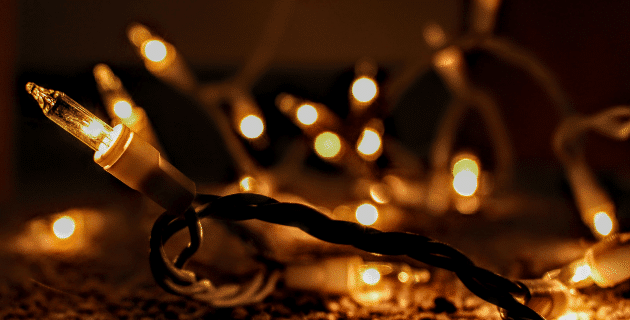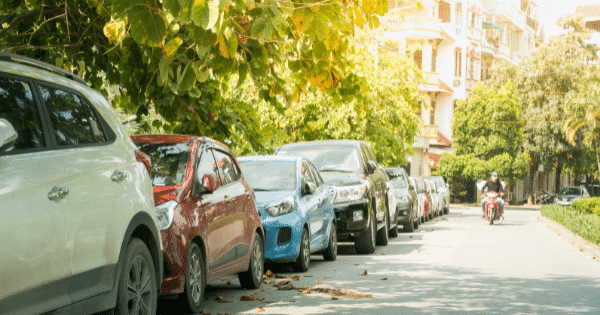
by California Casualty | Homeowners Insurance Info |
It’s the holidays and if you’re like most Americans, you’re pulling out the extension cords. Whether you’re planning a fantastic holiday light display or you simply need to power an extra item or two, remember that safety is key.
Extension cords are responsible for about 3,300 home fires annually, including holiday fires, killing 50 and injuring 270 people each year, according to the Electrical Safety Foundation International. That’s why it’s important to know how to choose and use these cords safely.
Follow these tips for extension cord safety this holiday season.
When buying extension cords, consider these important factors.
-
- Select a cord that is approved by an independent testing lab such as Underwriters Laboratories (UL), Intertek (ETL), or CSA-International (CSA).
- Choose a cord with a 3-prong plug and if possible, a polarized one. Polarized plugs can only be inserted into an outlet one direction, because the blade on one side is wider than the other.
- If you’ll be using the cord outside, choose one marked for outdoor use. Outdoor extension cords have more insulation, which protects them from varying temperatures, sunlight, and unintentional scrapes.
- Select a cord that is long enough for your needs. Never plug an extension cord into another extension cord to extend it. That’s not safe.
- Know what you are powering and choose a cord that can provide the right load amount. If you buy one with insufficient power for your needs, you could overheat it and cause an electrical short or a fire.
- The thickness of the cord will be a clue to its power. Small appliances and electronics can use thin or flat cords. Larger ones need thick, round, low-gauge cords able to handle a higher amperage/watt flow. The amperage is the measure of electrical current flow. The wattage is the amount of electrical power of an appliance or lamp.
- Look at the label on the cord and match it to your electrical needs. If you’re unsure, ask for help from the retailer.
- Length makes a difference. The longer the cord, the more chance for voltage to drop. If you’re running a 50-foot cord, select a higher rating to account for that loss.
When using extension cords, remember these do’s and don’ts.
Don’t…
… power multiple appliances with one cord.
… remove the third prong from your plug to fit in a 2-prong outlet. That could open the way for a nasty electrical shock.
… run cords under rugs or furniture. If the heat has nowhere to escape, it could cause a fire
… tape cords to floors or attach them with staples or nails, which could compromise the wiring.
… bend or coil extension cords that are in use.
… put cords across highly trafficked areas. They can be a tripping hazard.
… plug extension cords into power strips that are then plugged into outlets. This presents a similar danger to plugging extension cords into other extension cords—and heightens the risk of a fire.
… don’t use extension cords with heaters or fans. The risk of overheating is too great.
… don’t use extension cords that feel hot to the touch.
Do…
… check for frays, loose wires, and other damage. If you see any, throw out the cord and use another.
… insert prongs fully so no part of the metal is exposed while the extension cord is in use.
… cover unused cord receptacles with childproof covers.
… keep pets away from extension cords. Spray the cord with Bitter Apple to discourage chewing.
… pull the plug – and not the cord — when disconnecting from the socket. Pulling the cord could damage the wire and also present a shock hazard.
… store cords indoors and throw away damaged cords.
Remember that extension cords are designed to be temporary. If you’re using them on a permanent basis, it may be time to update your home’s electrical system.
Finally…a word about power strips
Power strips add extra outlets when you need them. That doesn’t mean you should use every outlet in the strip. Just like extension cords, power strips have electrical load limits. Check the rating, and make sure your power strip includes a built-in surge protector. These protect from a spike in electric current that can damage your electronics or appliances.
The personal property coverage in your homeowner’s insurance may cover damages from a power surge or electrical fire. Check with your insurer.
This article is furnished by California Casualty, providing auto and home insurance to educators, law enforcement officers, firefighters, and nurses. Get a quote at 1.866.704.8614 or www.calcas.com.

by California Casualty | Homeowners Insurance Info, Pets |
You came home to a rug that’s been chewed to shreds and a mess on the carpet—again. Now your house is smelling (and looking) a bit like a kennel… You love your dog, so you’re thinking it may be time to scrap the carpet altogether.
But think twice before you make any rash decisions. Carpets have so many advantages for your home! They muffle noise. Dogs won’t slip and slide on them like they can on hard surfaces. You also don’t have to worry about their claws scratching your hardwood floor. Plus, carpets are a soft place for your feet and for their paws.
The good news is that dogs and carpets can actually coexist nicely. Here’s what you need to know.
Choose the right carpet.
Not all carpets are the same when it comes to protecting against pet stains and messes. Look for carpets made of nylon, wool, or a material known as olefin. The most popular option, nylon is durable and easy to clean. It also has built-in stain resistance. Wool, the more expensive option, has some natural stain resistance but cannot be treated with a stain-resistant coating. Olefin was originally used in outdoor carpets but has been engineered to have more of the feel of wool. It’s made from plastic fibers, is easy to clean, and repels moisture.
Take care of new messes right away.
Cleaning up after your pet is part of being a responsible pet owner. The best way to keep your carpet from staining is to address your pet’s accidents right away. If you use a store-bought cleaner, choose one with a neutral pH to help remove the acidity of your pet’s urine. You can also make your own cleaning solution from vinegar, baking soda, and water. Here are two natural methods for cleaning up pet urine on carpet.
Method #1
-
- Place a thick layer of paper towels over the wet spot.
- Cover the towels with layers of newspaper.
- Stand on the newspaper for a few minutes for it to absorb the urine.
- Remove the paper and paper towels and dispose of them.
- Rinse the area with cool water.
- Blot up the water with towels. If you have a wet vac, you can use that instead.
- Once most of the liquid is blotted, spread baking soda over it. Use ¼ cup or less. (Note that large amounts of baking soda are toxic to dogs so keep your fur baby away.)
- Let the mixture sit overnight and then vacuum the spot thoroughly the next morning. The area should feel clean to the touch.
Method #2
-
- In a clear spray bottle, mix one cup of distilled white vinegar with one cup of water and 2 teaspoons of baking soda. Shake it up.
- Spray the mixture on the stain.
- Let it sit for a few minutes and then blot it with a towel until clean.
You can use these methods for other pet messes such as vomit or poop. Remove the vomit or feces before treating the carpet, being careful not to embed it in the carpet fibers. Act quickly; the acid in vomit can quickly discolor your carpet.
Take care of old stains, too.
Old urine stains can cause a lingering odor in your home. You can take care of these stains in several ways. One way is to use an enzymatic cleanser that breaks down the stain at the molecular level. You can find these cleansers at pet stores. Another way is to rinse the area thoroughly with water, then use a wet-dry vacuum to clean it up. Importantly, do not use a steam cleaner. The heat can set the odor and stain permanently.
Not sure where the stains are? A blacklight can help you find them. The wavelengths of blacklight cause the proteins in urine to glow.
Add a carpet runner to high-traffic areas.
Consider a carpet runner or area rug over your wall-to-wall carpeting for an extra barrier. Place it in high-traffic areas or where your dog commonly goes. Carpet runners and area rugs may be picked up and cleaned, and more easily replaced, if needed.
Clean their paws and clean your carpet.
There’s a lot of preventive care that you can take to keep your carpets clean. Start by wiping and drying your dog’s paws when your fur baby comes in from outside—especially on rainy, snowy, or muddy days. Then, take care of your carpet by vacuuming regularly and shampooing your carpet every 12 months to remove dirt, grime, and allergens. You can schedule a professional carpet cleaning or do it yourself.
Train your pet.
When you adopted your pet, you made the commitment to stick with them through the good and the bad. Oftentimes bad behavior like going to the bathroom on the carpet can be un-trained. You can do this by kennel training when you are gone or using a reward method when they go outside. If you need help, talk to your pet’s veterinarian for ways you can teach your pet to unlearn these behaviors or find a local trainer! You may think you are doing them a favor by not disciplining them when they make a mess or start chewing on furniture, but really you are getting in the way of the great pet they have the potential of becoming- by not letting them learn that these behaviors are ‘bad’.
Keep in mind the age of your pet plays a factor. A puppy or an older dog may need extra attention and may have more accidents than a dog in its prime.
Does homeowner’s insurance cover damage from your pets?
Unfortunately, homeowner’s and renter’s insurance both do not cover the damage your pet does to your carpet—or to any of your personal property. Take note that even your carpet warranty probably does not cover pet damage. If your pet, however, gets loose and damages property at your neighbor’s, the liability coverage in your homeowner’s policy may kick in and cover some of the costs.
This article is furnished by California Casualty, providing auto and home insurance to educators, law enforcement officers, firefighters, and nurses. Get a quote at 1.866.704.8614 or www.calcas.com.

by California Casualty | Educators |
If you’re a teacher, chances are you’ve gotten your share of apple-themed gifts—and probably more than a few shiny red apples. In honor of National Eat a Red Apple Day, December 1, let’s explore the history of how the red apple became the iconic symbol for teachers everywhere.
Education for Apples
Early on in the U.S., teachers were housed, fed, and paid by the community in which they taught. Poor families who could not afford the teacher’s low wages would pay with produce. The early apples were bitter, sour, and smaller than the ones we’re used to. But apples were popular because of their bartering value. They could be made into hard cider, considered safer to drink than water. Apples also could be eaten fresh, fried, stewed, and baked. They could be made into vinegar, brandy, preserves, and apple butter. They could be dried for the winter and eaten year-round.
Years later, after Prohibition, apples started to become marketed as an essential part of a healthy diet- hence the term, “an apple a day keeps the doctor away”. Apples were still being given to teachers, but this time from their students.
The first day of school occurs near the beginning of September, coincidentally apple harvest time. Apples grow in every state in the continental U.S. They’re cheap and pretty, especially when they are buffed until they shine. That made apples the ideal first-day teacher gift. It was a way for students to show appreciation and get the year started on the right foot with a sweet, and healthy treat for their teacher.
Today, there are foundations and awards for educators, like the Golden Apple Foundation. Apples continue to decorate classrooms and hallways. Apple mugs, earrings, shirts, ties, notebooks, etc. line the aisles at grocery stores for teachers. The apple is and will continue to be a powerful symbol of knowledge and education because just like apples, teachers are an essential part of helping our children grow.
Celebrate Red Apple Day with your students!
Here are 5 apple-themed activities for Eat a Red Apple Day, or any day that you’d like to celebrate apples and sweeten the learning experience.
-
- Conduct an apple taste test. Put out samples of three varieties of apples. Then have students describe them and rank them.
- Read an apple-themed book.
- Teach fractions, counting/sorting or measurement using apple-inspired math.
- Make an apple-inspired art project.
- Visit an apple orchard, learn how to plant an apple tree, and more in these engaging videos.
Do you have a favorite apple-themed activity? Please share in the comments.
This article is furnished by California Casualty, providing auto and home insurance to educators, law enforcement officers, firefighters, and nurses. Get a quote at 1.866.704.8614 or www.calcas.com.

by California Casualty | Educators |
Is it time for break yet? We’re counting down the seconds. While some may already be enjoying their time at home with friends and family others are in the classroom right up until Thanksgiving day. Your main goal is to keep students busy and on-task, but even...

by California Casualty | Auto Insurance Info |
Have you ever passed up a spot because it required you to parallel park? Don’t worry, you’re not alone. The anxiety/stress that comes with parallel parking is well known. But it doesn’t have to be.
Whether you’re teaching your teen how to parallel park or you simply want to brush up on your technique, here’s a 5-step process to parallel park like a pro.
1. Find a parking spot.
Look for a spot that seems big enough. You will need a space about one and a half times the length of your car. It takes practice to estimate the right size so don’t get discouraged. If you’re not sure if the spot is big enough, pull away and find another.
2. Signal and get in position.
You will be pulling up alongside the car in front of the empty spot. Check your mirrors and your surroundings for other cars and pedestrians. Turn on your right turn signal. Position your car so that its center is even with the other car’s rear bumper. You should be parallel, about 2-3 feet away from the other car.
3. Turn the wheel to the right and reverse.
Sit up tall and turn your body 90 degrees. Again, check your surroundings. When all is clear, put the car in reverse and turn the steering wheel sharply toward the curb so you are approaching at 45-degree angle. Use your car’s backup camera to help guide you. Stop when you see the full front of the car in the back of you in your driver’s side mirror. If your right rear wheel taps the curb, move forward a bit.
4. Turn the wheel in the opposite direction to straighten out.
You can’t continue on that 45-angle without hitting the curb. That means that sometime during your reverse, you will need to stop turning toward the curb and start turning in the other direction. For most cars, you do this when your passenger’s side mirror is in line with the rear bumper of the car in front. As you turn the wheel in the other direction, continue backing up slowly until your car is parallel to the curb.
5. Straighten and align.
You want to make sure you’re between 12 and 18 inches from the curb. Your backup camera will give you an idea of how close you are. You also want to be centered in the spot so that you, and the cars in front and behind you, can get out easily. Creep forward until you are centered. Congratulations! You just parallel parked successfully.
Hi-tech help from your vehicle
When they first came out, backup cameras were revolutionary in helping with parallel parking. The latest technologies are even more so. Parallel parking assist is available on some newer models in a variety of price points. These systems use a camera and sensor-based guidance system that steers the car into the space with little help from the driver.
Simply drive past a parking spot and the car will notify you if it is large enough. Then, select the spot, put it in reverse, engage the parallel parking assist option, and remove your hands from the wheel. Self-parking cars can even do it themselves, and the driver is optional. You can even stand outside the car and use a remote control!
Quick Parallel Parking Safety Tip: Remember to never park in front of a hydrant or fire lane.
Drive safe!
This article is furnished by California Casualty, providing auto and home insurance to educators, law enforcement officers, firefighters, and nurses. Get a quote at 1.866.704.8614 or www.calcas.com.





